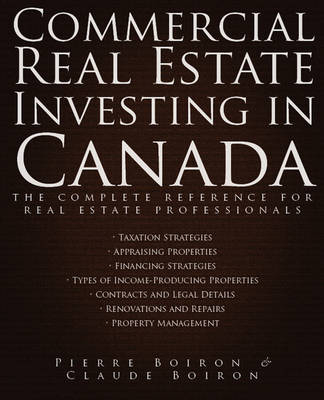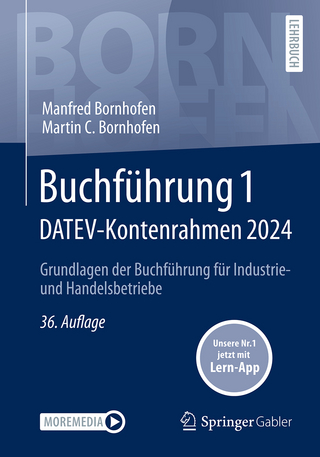
Commercial Real Estate Investing in Canada
John Wiley & Sons Inc (Verlag)
978-0-470-83840-2 (ISBN)
- Titel z.Zt. nicht lieferbar
- Versandkostenfrei
- Auch auf Rechnung
- Artikel merken
The business of real estate
Land-use controls
Taxation of property
Types of income-producing properties
Renovations and repairs
Property management
Property appraisals
Conducting due diligence
Real estate contracts
And much more! Commercial Real Estate Investing in Canada is a tremendously valuable and indispensable tool to all Canadian real estate investors, agents, brokers, property managers, landlords, loan officers, builders, and lawyers.
Pierre Boiron (Thornhill, ON) is a sales representative with Coldwell Banker Commercial. Pierre has over 30 years of commercial real estate investing experience, during which time he became an FRI, S.I.O.R, and Ontario Land Economist. Pierre is a member of the Toronto Real Estate Board, the Ontario Real Estate Association, The Canadian Real Estate Association, and The Greater Toronto Home Builders Association. Claude Boiron (Thornhill, ON) is a Realtor.
Part 1: Introduction to Commercial Real Estate Investing. CHAPTER 1: INTRODUCTION.
1.1 Types of Real Estate Investors.
1.2 Purpose of This Book.
1.3 Is this Book for You?
1.4 Scope of This Book.
1.5 Overcoming the Barriers to Success.
CHAPTER 2: THE BUSINESS OF COMMERCIAL REAL ESTATE.
2.1 Sorting Out the Terms.
2.2 Commercial Real Estate Defined.
2.3 Benefits of Investing in Commercial Real Estate.
2.4 Evaluating the Market Outlook.
2.5 Building Wealth through Real Estate Investing.
CHAPTER 3: THE SUCCESSFUL INVESTOR.
3.1 Understanding Risk.
3.2 Developing Your Investment Plan.
3.3 Excessive Caution Leads to Paralysis.
Part 2: Understanding the Industry.
CHAPTER 4: LAND USE CONTROLS.
4.1 Planning in Ontario.
4.2 Zoning and Zoning By-laws.
4.3 Site Plans and Site Plan Controls.
4.4 Building Permits.
4.5 Committee of Adjustment.
4.6 Ontario Municipal Board.
4.7 Heritage Properties.
4.8 Working with Planners.
CHAPTER 5: TAXATION.
5.1 Property Taxes.
5.2 Income Taxes.
CHAPTER 6: FORMS OF PROPERTY OWNERSHIP.
6.1 Fee Simple Ownership.
6.2 Life Estate.
6.3 Joint-Tenancy.
6.4 Tenancy-in-Common.
6.5 Leasehold Estate.
6.6 Syndicates.
6.7 Vehicles to Invest in Real Estate.
CHAPTER 7: CONTRACTS AND OTHER LEGAL DETAILS.
7.1 Contracts for Real Property Transactions.
7.2 Agreement of Purchase and Sale.
7.3 Offer to Lease.
7.4 Lease.
7.5 Estoppel Certificate.
7.6 Affidavit.
7.7 Lawyers and Arbitration Clauses.
7.8 Small Claims Court.
CHAPTER 8: REAL PROPERTY REGISTRATION.
8.1 Land Ownership Controls.
8.2 Land Transfer Tax Affidavit.
8.3 Transfer of Title.
8.4 Surveys and Reference Plans.
8.5 Certification of Titles Act.
8.6 Document Registration.
8.7 Other Registered Documents.
8.8 Electronic Land Registration.
8.9 Title Insurance.
8.10 Online Tools.
Part 3: Finance
CHAPTER 9: UNDERSTANDING REAL ESTATE FINANCIAL TERMINOLOGY.
9.1 The Three-Variable Formulas.
9.2 Gross Income Multiplier (GIM).
9.3 Net Income Multiplier (NIM).
9.4 Potential Gross Income (PGI).
9.5 Vacancies and Bad Debts (V&BD).
9.6 Gross Operating Income (GOI).
9.7 Operating Expenses (OE).
9.8 Net Operating Income (NOI).
9.9 Annual Debt Service (ADS).
9.10 Debt Service Coverage Ratio (DSCR).
9.11 Default Ratio (DR).
9.12 Cash Flow Before Taxes (CFBT).
9.13 Cash Flow After Taxes (CFAT).
9.14 Operating Expense Ratio (OER).
9.15 Return on Equity Rate (ROE).
9.16 Capital Improvements.
9.17 Building Coverage Ratio (BCR).
CHAPTER 10: FINANCIAL ANALYSIS.
10.1 Step-by-Step Analysis of a Property.
10.2 Measuring Return on Investment.
10.3 Payback Method.
10.4 Capitalization Rate (Cap Rate or CR).
10.5 Capitalization Terminology.
10.6 Net Present Value (NPV).
CHAPTER 11: FINANCING.
11.1 Leveraging.
11.2 Understanding Mortgages.
11.3 Introduction to Interest.
11.4 Mortgage Amortization.
11.5 Types of Mortgages.
11.6 Bonds, Commercial Paper and Conduit Financing.
11.7 How Lenders Set Mortgage Amounts.
11.8 Band of Investment Theory.
11.9 CMHC and Mortgage Insurance.
11.10 The Federal Interest Act.
CHAPTER 12: APPLYING FOR A MORTGAGE.
12.1 Sources of Mortgages.
12.2 Dealing with Mortgage Brokers.
12.3 Mortgage Fees.
12.4 Dangers of Mortgage Transfer.
12.5 Clarifying and Comparing Mortgage Terms.
12.6 Negotiating Mortgage Terms.
12.7 Gathering Information to Apply for a Mortgage.
12.8 Mortgage Application Process.
12.9 Mortgage Defaults.
Part 4: Buying, Selling and Leasing.
CHAPTER 13: REAL ESTATE AGENCIES.
13.1 Understanding the Roles.
13.2 The Agency Relationship.
13.3 How to Select a Real Estate Agent.
13.4 How to Work with an Agent.
13.5 How Agents Are Paid.
13.6 How to List a Property.
13.7 The Multiple Listing System.
13.8 The Agent as Marketer.
13.9 Getting a Real Estate License.
CHAPTER 14: APPRAISALS AND FEASIBILITY STUDIES.
14.1 What Is an Appraisal?
14.2 Uses of Appraisals.
14.3 Principles of Value.
14.4 Market Value Versus Value in Use.
14.5 Appraisal Approaches.
14.6 Land Valuation.
14.7 Criticizing Appraisals.
14.8 Feasibility Studies.
CHAPTER 15: POINTS TO CONSIDER BEFORE BUYING EACH TYPE OF PROPERTY.
15.1 Quoting Commercial Rents.
15.2 Industrial Buildings.
15.3 Retail Buildings.
15.4 Office Buildings.
15.5 Multi-Family Buildings.
15.6 Comparing the Types of Income-Producing Properties.
15.7 Investment Property Databank (IPD).
CHAPTER 16: BUYING AND SELLING.
16.1 Buying a Good Investment Property.
16.2 Making an Offer.
16.3 Negotiating with a Vendor.
16.4 Closing Costs.
16.5 Typical Steps to Completing a Purchase.
16.6 Environmental Site Assessment (Audit/Report).
16.7 Environmental Insurance.
16.8 Selling a Commercial Property.
16.9 The Lease-Purchase Option.
16.10 Buying Your First Investment Property.
CHAPTER 17: LEASING.
17.1 Finding Tenants.
17.2 Marketing the Property.
17.3 Ownership Versus Leasing.
17.4 Background Checks on Retail, Office and Industrial Tenants.
17.5 Background Checks on Residential Tenants.
17.6 Tenant Danger Signs.
17.7 Dealing with Offers to Lease.
17.8 Establishing a Good Tenant/Landlord Relationship.
Part 5: Managing Your Properties.
CHAPTER 18: PROPERTY MANAGEMENT.
18.1 Managing Your Tenants.
18.2 The Appearance of a Building.
18.3 My Property Has Problems.
18.4 Alternate Uses.
18.5 Floor Measurements.
18.6 Renovating and Maintenance Tips.
18.7 Your Property Management Team.
18.8 Property Management Courses.
CHAPTER 19: RENOVATIONS, REPAIR, AND BUILDING COMPONENTS.
19.1 Building Exterior.
19.2 Surface Care.
19.3 Building Services.
19.4 Insulation.
19.5 Construction and Renovation.
19.6 Improving a Building for Sale or Lease.
19.7 Underground Storage Tanks (USTs).
19.8 Locks and Security Systems.
19.9 Building Stairways.
19.10 Intelligent Buildings.
APPENDIX 1: CHECKLISTS.
APPENDIX 2: ADDITIONAL RESOURCES.
2.1 Associations and Organizations.
2.2 Books.
2.3 Glossaries of Relevant Terminology.
2.4 Government.
2.5 Legal.
2.6 Information for Landlords and Owners.
2.7 Technical Information and Suppliers.
APPENDIX 3: GLOSSARY OF ACRONYMS.
INDEX.
| Verlagsort | New York |
|---|---|
| Sprache | englisch |
| Maße | 230 x 275 mm |
| Gewicht | 1375 g |
| Themenwelt | Wirtschaft ► Betriebswirtschaft / Management ► Rechnungswesen / Bilanzen |
| ISBN-10 | 0-470-83840-X / 047083840X |
| ISBN-13 | 978-0-470-83840-2 / 9780470838402 |
| Zustand | Neuware |
| Informationen gemäß Produktsicherheitsverordnung (GPSR) | |
| Haben Sie eine Frage zum Produkt? |
aus dem Bereich


